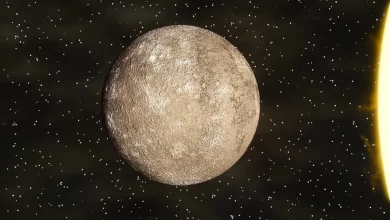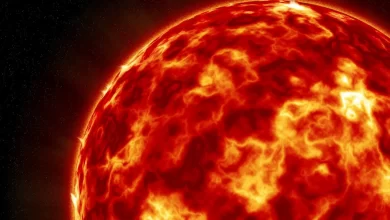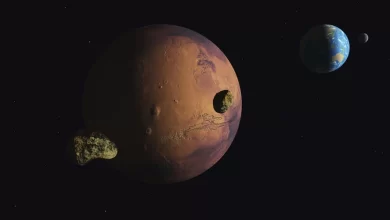Mars is the fourth planet in the solar system. This means that Earth and Jupiter are Mars’ neighbors. Mars has been known since ancient times because it can be seen without the use of sophisticated telescopes. For many years, Mars has existed as a hopeful “Planet B” — a secondary option in case Earth can no longer support us as a species.
- Mars is half the size of our blue planet, earth. The circumference of earth is 40,075 km, whereas mars circumference is 21,344 km.
- The red planet has two moons named Phobos and Deimos. Phobos is the larger of two and is about 15 miles long by 10 miles wide. Phobos is in a low orbit region which causes it to circle mars three times a day.
- If you weigh 90 kilograms (200 pounds) on earth, you would weigh only 34 kilograms (76 pounds) on Mars because of the difference in gravity. No need for diets on Mars then!
- The brightest stars in the night sky are not actually stars, but the planets Jupiter, Venus, Mars, and Mercury.
- The tallest volcano in the solar system is called Olympus Mons. Its peak is 27 kilometers (16.88 miles) above the surface of Mars. It is three times the height of Mount Everest and covers an area nearly the size of France.
- We know Mars as the ‘Red Planet’ because it looks like an orange-red star in the sky. Due to this color, the ancient Greeks and Romans gave it a name after their god of war. But now we know how mars got its color; it is due to the rust in the rocks of Mars.
- Mars was once better mapped than Alaska.
- In the orbits of the planets Mars and Jupiter, there is the largest group of known asteroids – the area known as the asteroid belt. It has been estimated that the asteroid belt contains anywhere around 1.1 to 1.9 million asteroids which are larger than 1 km (0.6 mi) in diameter.
- Mars has extremely low temperatures; on average, the temperature on the red planet is about minus 60 degrees Celsius (minus 80 degrees Fahrenheit). In winter, near the poles, temperatures can get down to minus 125 degrees C (minus 195 degrees F). The lowest temperature ever recorded On earth was in Antarctica in July 1983. The temperature was recorded at Russia‘s Vostok Station and was minus 89 degrees C (minus 128 degrees F).
- Mars has the longest and deepest canyon in the solar system, the Valles Marineris. If it was on earth, it would stretch right across the United States.
- It takes sunlight 8 minutes to reach earth, 12 minutes 47 seconds to reach Mars, and 5.5 hours to get to Pluto.
- The popular “Face on Mars” that was thought to be a human face was actually the result of the photograph taken by the 1976 Viking 1 rover showing a huge rock formation very similar to the human face.
- The most difficult problem to any future human mission to Mars is to ensure reliable radio communication because Sun often blocks communication between Earth and Mars.
- Mars has about 15% of the earth’s volume and 11% of the earth’s mass.
- In the 1970s, the US Vikings 1 and 2 and the Soviet Mars 3 and 5 probes all reached the surface of Mars.
- Dry ice evaporating on the surface of Mars in spring can trigger avalanches!
- Many evidences have been gathered by scientists suggesting that Mars was once significantly more habitable than it is today, but scientists are still far from answering whether living organisms ever existed on Mars or not.
- It takes two earth years for Mars to complete one orbit around the Sun.
- The tallest mountain in the solar system is the volcano, Olympus Mons, on Mars at the height of about 16 miles, and has lava flows that are so young that some scientists think it could still be active. Olympus Mons has a sheer cliff at its outer edge, towering 5 miles tall.
- The entire surface of Mars was likely shaped by liquid water about 4 billion years ago. The red planet would have been a warmer place than today, with rivers, lakes, and small seasons on its surface.
- Martian dust storms occur every two to four Mars years and are so powerful that they can cover the whole planet with dust for months.
- The deepest surface point on Mars is Hellas, about 3 km deep.
- Dried-up riverbeds show that Mars probably once had water on its surface. There could be water underground and can be ice at the poles sometimes.
- Living microorganisms, such as methanogens, are another possibility of microbial life on Mars, but no evidence for the presence of such organisms has been found on the red planet until June 2019 as methane was detected by the Curiosity rover.
- Many recent studies believe that Mars was struck by a Pluto-sized body about four billion years ago. A direct result of this struck was the Borealis basin that covers 40% of the planet.
- Most of the surface of Mars is composed primarily of basalt. Basalt is black and fine-grained extrusive volcanic rock.
- According to scientists, Gold exists on Mars, Mercury, and Venus.
- Mars is full of craters; currently, more than 43,000 craters with a diameter of 5 km or greater have been found.
- The Martian “day” is only slightly longer than a day on earth. On Mars, a day is 24 hours, 37 minutes, 23 seconds long, whereas, on earth, a day is 23 hours 56 minutes, 04 seconds long.
- Until 2020, there have been 49 Mars missions such as orbiter and rovers.





